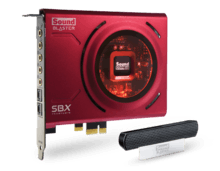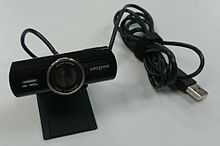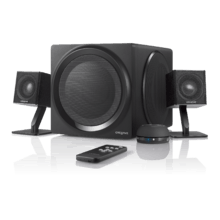Creative Technology Limited
|
| |
| Public (SGX: C76) | |
| Industry | Consumer electronics |
| Founded | July 1, 1981 |
| Founder |
Sim Wong Hoo Ng Kai Wa[1] |
| Headquarters | Jurong East, Singapore |
Area served | Worldwide |
Key people |
Sim Wong Hoo, (CEO) Ng Keh Long (CFO) |
| Products | Multimedia, IT, Consumer electronics |
| Revenue |
|
| Profit |
|
Number of employees | 800 (2012)[3] |
| Divisions | THX(60%) |
| Subsidiaries | ZiiLABS, E-mu Systems and Ensoniq (merged), Cambridge SoundWorks |
| Website |
www |
Creative Technology Ltd. is a Singapore-based global company headquartered in Jurong East, Singapore. The principal activities of the company and its subsidiaries consist of the design, manufacture and distribution of digitized sound and video boards, computers and related multimedia, and personal digital entertainment products.
It also partners with mainboard manufacturers and laptop brands to embed its Sound Blaster technology on their products.[4]
History
The firm began as a computer repair shop, where Sim Wong Hoo developed an add-on memory board for the Apple II computer. Later, they started creating customized PCs adapted in Chinese. A part of this design included enhanced audio capabilities, so that the device could produce speech and melodies. The success of this audio interface led to the development of a standalone sound card.
In 1987, they released a 12-voice sound generator sound card for the IBM PC architecture, the Creative Music System (C/MS), featuring two Philips SAA1099 chips. Sim personally went from Singapore to Silicon Valley and managed to get RadioShack's Tandy division to market the product.[5] The card was, however, unsuccessful and lost to AdLib. Learning from this, Creative produced the first Sound Blaster, which included the prior CM/S hardware but also incorporated the Yamaha YM3812 chip (also known as OPL2) that was found on the AdLib card, as well as adding a component for playing and recording digital samples. The firm used aggressive marketing strategies, from calling the card a "stereo" component (only the C/MS chips were capable of stereo, not the complete product) to calling the sound producing micro-controller a "DSP" (for "digital sound processor"), hoping to associate the product with a digital signal processor (the DSP could encode/decode ADPCM realtime, but otherwise had no other DSP-like qualities).
The firm's Sound Blaster sound card was among the first dedicated audio processing cards to be made widely available to the general consumer. The card soon became a de facto standard for sound cards in PCs for many years, mostly by the fact that it was the first to bundle what is now considered to be a part of a sound card system: digital audio, on-board music synthesizer, MIDI interface and a joystick port. This continued until the 2000s when OEM PCs began to be built with sound boards integrated directly onto the motherboard, and the Sound Blaster found itself reduced to a niche product.
Monaural Sound Blaster cards were introduced in 1989, and stereo cards followed in 1992 (Sound Blaster Pro). Wavetable MIDI was added with the 16-bit Sound Blaster AWE32 and AWE64 with 32 and 64 voices.
In the mid 1990s, the firms ventures into the CD-ROM market proved to be unsuccessful. The firm was forced to write off nearly US$100 million in inventory when the market collapsed due to a flood of cheaper alternatives.[6]
The firm had maintained a strong foothold in the EISA PC audio market until July 14, 1997 when Aureal Semiconductor entered the soundcard market with their very competitive PCI AU8820 Vortex 3D sound technology. The firm at the time was in development of their own in house PCI audio cards but were finding little success adopting to the PCI standard. In January 1998 in order to quickly facilitate a working PCI audio technology, the firm made the acquisition of Ensoniq for US$77 million. On March 5, 1998 the firm sued Aureal [7] with patent infringement claims over a midi caching technology[8] held by E-mu Systems. Aureal filed a counterclaim[9] stating the firm was intentionally interfering with its business prospects, had defamed them, commercially disparaged, engaged in unfair competition with intent to slow down Aureals sales and acted fraudulently. The suit had come only days after Aureal gained a fair market with the AU8820 Vortex1.
In August 1998 the Sound Blaster Live! was the firms first sound card developed for the PCI bus in order to compete with upcoming Aureal AU8830 Vortex2 sound chip.[10] Aureal at this time were making fliers comparing their new AU8830 chips to the now shipping Sound Blaster Live!. The specifications within these fliers comparing the AU8830 to the Sound Blaster Live! EMU10K1 chip sparked another flurry of lawsuits against Aureal,[11] this time claiming Aureal had falsely advertised the Sound Blaster Live! capabilities.[12]
In December 1999 after numerous lawsuits, Aureal won a favorable ruling but went bankrupt as a result of legal costs and their investors pulling out. Their assets were acquired by Creative through the bankruptcy court in September 2000 for US$32 million.[13] The firm had in effect removed their only major direct competitor in the 3D gaming audio market, excluding their later acquisition of Sensaura.
In April 1999, the firm launched the NOMAD line of digital audio players that would later introduce the MuVo and ZEN series of portable media players. In November 2004, the firm announced a $100 million marketing campaign to promote their digital audio products, including the ZEN range of MP3 players.[14]
The firm applied for U.S. Patent 6,928,433 on January 5, 2001 and was awarded the patent on August 9, 2005.[15] The ZEN Patent was awarded to the firm for the invention of user interface for portable media players. This opened the way for potential legal action against Apple's iPod and the other competing players. The firm took legal actions against Apple in May 2006. In August, 2006, Creative and Apple entered into a broad settlement,[16] with Apple paying Creative $100 million for the license to use the Zen patent. The firm then joined the "Made for iPod" program.
On March 22, 2005, The Inquirer reported that Creative Labs had agreed to settle in a class action lawsuit about the way its Audigy and Extigy soundcards were marketed. The firm offered customers who purchased the cards up to a $62.50 reduction on the cost of their next purchase of its products, while the lawyers involved in filing the dispute against Creative received a payment of approximately $470,000.[17]
In 2007, Creative voluntarily delisted itself from NASDAQ, where it had the symbol of CREAF.[18] Its stocks are now solely on the Singapore Exchange (SGX-ST). In early 2008, Creative Labs' technical support center, located in Stillwater, Oklahoma, laid off several technical support staff, furthering ongoing concerns surrounding Creative's financial situation.
In January 2009, the firm generated internet buzz with a mysterious website[19] promising a "stem cell-like" processor which would give a 100-fold increase in supercomputing power over current technology, as well as advances in consumer 3D graphics.[20] At CES 2009, it was revealed to be the ZMS-05 processor from ZiiLABS, a subsidiary formed from the combining of 3DLabs and Creative's Personal Digital Entertainment division.[21]
In November 2012, the firm announced it has entered into an agreement with Intel Corporation for Intel to license certain technology and patents from ZiiLABS Inc. Ltd, a wholly owned subsidiary of Creative, and acquire certain engineering resources and assets related to its UK branch as a part of a $50 million deal. ZiiLABS (still wholly owned by Creative) continues to retain all ownership of its StemCell media processor technologies and patents, and will continue to supply and support its ZMS series of chips to its customers.[22]
Products
Sound Blaster

Creative Sound Blaster is one of the most recognized names in the PC audio market. In 1987, the Creative Music System was released as the first audio device from the firm. In 1988, the firm took the Creative Music System and marketed it at RadioShack as Game Blaster. The Sound Blaster 1.0 released within the following year assisted by full compatibility with the then market leader Ad Lib, Inc.'s sound card, allowed the firm to achieve competitive control of the PC audio market by 1992. AdLib unable to continue sales of their cards were then forced into bankruptcy.
Current line-up of Sound Blaster sound cards includes a feature SBX Pro Studio that intelligently restores the highs and lows of compressed audio files, enhancing the detail and clarity. SBX Pro Studio also contains settings that allow the user to improve their audio bass and virtual surround.[23]
ZEN and MuVo Branded Portable Media Devices
The Creative ZEN name is used in a range of handheld media devices by the company. They are the successor to the NOMAD line of players. The line has won several awards, including three CES Best of Show awards, in 2004 with the Creative ZEN Portable Media Center,[24] 2005 with the ZEN MicroPhoto,[25] and 2006 with the ZEN Vision:M.[26]
In 2008, the ZEN X-Fi was released. It is a digital media player with X-Fi Crystallizer®.[27] Creative Technology subsequently released the ZEN X-Fi2 in 2009 and ZEN X-Fi3 in 2011. The ZEN X-Fi2 features a resistive 3-inch TFT LCD touch screen and has no Wi-Fi support.[28] The ZEN X-Fi3 features a 2-inch non-touch TFT display with touch buttons. It supports Bluetooth 2.1 and apt-X codec.[29]
The company uses MuVo branding for its smaller, flash-based devices.
Vado Video Cameras
While already a vendor of webcams for PCs and laptops, in May 2008, Creative announced the unveiling of its Vado video camera.[30] The Vado video camera is a handheld device designed for portability, as a direct competitor to the Flip Video. In December 2008,[31] the firm announced a HD version of the Vado, the Vado HD. This camera was among the first portable high-definition cameras. The Vado HD received an 89 rating from PCWorld,[32] 4/5 stars and an Editors Choice award from PC Magazine,[33] and generally favorable reviews from users on Amazon.[34]
MediaSource
Creative MediaSource is software included with certain of the firm's products, such as Sound Blaster, MuVo, and Creative Zen. It is mainly used as a method to sync and transfer digital media.
Live! Cam Series Web Cameras

Live! Cam is a series of web cameras for video chats, taking photos and recording videos.
The webcams can work on Windows XP SP2, Windows Vista, Windows 7, Windows 8, Mac OS X 10.5 and Linux Kernel V2.6. However, the bundled software can only work on Microsoft Windows. The bundled software allows noise cancellation for voices in video chats.
The maximum performance of Live! Cam Connect HD 1080, Live! Cam Sync HD and Live! Cam Chat HD for Skype video calls is VGA at 30 frames per second. The maximum performance of Live! Cam Connect HD for Skype video calls is 720p at 30 frames per second.
There are two versions of bundled software for the webcams, Live! Central 3 and Live! Central 3 Lite. The difference between the two software lies in Live! Central 3 allows visual effects like adding on a virtual eyewear, hair, headgear, moustache and face effects. It allows the change of scenes in a video chat and adding photos and PowerPoint slides to video chats. It also allows the sharing of a user’s desktop in video chats. Live! Central 3 also has got features of Live! Central 3 Lite.
Live! Central 3 Lite allows the adjustment of video settings, on/off noise cancellation in chat and on/off parental control.
List of Live! Cam Series Web Cameras
- Live! Cam Connect HD 1080
- Live! Cam Sync HD
- Live! Cam Connect HD
- Live! Cam Chat HD
Creative MUVO Series Speakers
The Creative MUVO 10, MUVO 20 and MUVO mini are portable Bluetooth speakers. All three speakers are Bluetooth 4.0 speakers and can be connected via NFC. They have got a built-in microphone for answering phone calls when paired with smart phones. They support A2DP (Wireless Stereo Audio), AVRCP (Bluetooth Remote Control) and HFP (Hands-Free profile) Bluetooth profiles. All three speakers support the SBC codec while the MUVO 20 also supports the aptX codec.
The Creative MUVO 10 and MUVO 20 have got two 3-inch full-range drivers and a port tube for bass. The MUVO 10 weights 0.967 kg/2.14 lbs and the MUVO 20 weighs 1.016 kg/2.24 lbs.
The Creative MUVO mini is the smallest and lightest of the three speakers. It has got two full-range micro drivers and passive driver for bass. It weighs 0.285 kg/10.01 oz. It is IP66 certified making it dust and water jets resistant. It is not fully water proof as it cannot be submerged in water.
Other products

- Sound Blaster and Fatal1ty branded gaming headsets
- Gigaworks series computer speakers
- Inspire series computer speakers
- HansVision E-dictionary (Chinese language)
- hanZpad Android Tablet (For OEMs)
- WP Series Bluetooth wireless headphones and earphone
- MA Series For Android headphones and earphones
- HN/HS/HQ Headset Series headphones and earphones
- EP Earphones Series earphones
- Aurvana Series headphones and earphones
- Creative ZiiSound Bluetooth speaker and wireless subwoofer
- Creative Sound BlasterAxx Series speakers
(Only Sound BlasterAxx SBX 8 does not have Bluetooth capability)
- Creative Sound Blaster Roar Bluetooth speaker
- Creative Sound Blaster E1, E3 and E5 headphone amplifier
- Creative Sound Blaster X7[35]
- Creative Sound Blaster Jam Bluetooth headset
Discontinued products
- CD and DVD players, drives, and controller cards
- Graphics cards
- Prodikeys, a computer keyboard-musical keyboard combination
- Optical mice and keyboards
- VadoHDs
- Creative MuVos
See also

- AdLib
- Aureal Semiconductor
- Ensoniq
- Environmental audio extensions
- Yamaha
Divisions and brands
- Cambridge SoundWorks
- Creative MuVo
- Creative NOMAD
- Creative ZEN
- E-mu Systems
- Sound Blaster
- SoundFont
- Sensaura
- ZiiLABS, formerly 3dlabs
References
- ↑ http://www.answers.com/topic/creative-technology-ltd-usa-adr Answers.com : Reference Answers - Creative Technology Ltd.
- ↑ 2.0 2.1 "CREATIVE ANNOUNCES Q4 FY10 US GAAP FINANCIAL RESULTS".
- ↑ "Creative Technology Ltd. | Company profile from Hoover's". Hoovers.com. Retrieved 2010-11-11.
- ↑ (C) Creative Labs 1999-2015. "Creative OEM Partners". Retrieved 17 April 2015.
- ↑ Graham, Jefferson (2004-06-28). "Creative's name describes CEO". USA Today. Retrieved 2008-03-31.
- ↑ "Asiaweek.com - Technology - Creative's Genius - 9/29/2000". Retrieved 17 April 2015.
- ↑ Aureal And Creative Engage In Legal Skirmish
- ↑ "Creative Labs v. Aureal". Retrieved 17 April 2015.
- ↑ "Writs fly as Aureal countersues Creative Technologies". Retrieved 17 April 2015.
- ↑ "Aureal Welcomes Creative Labs to Competitive Marketplace.". Retrieved 17 April 2015.
- ↑ "Creative Files False Advertising and Other Claims Against Aureal.". Retrieved 17 April 2015.
- ↑ "A3D30prm". Retrieved 17 April 2015.
- ↑ "ALive!". Archived from the original on 10 October 2007. Retrieved 17 April 2015.
- ↑ Smith, Tony (2004-11-18). "The Register "Creative declares war on iPod", 18 November 2004". Theregister.co.uk. Retrieved 2010-11-11.
- ↑ "Press Relations". Retrieved 17 April 2015.
- ↑ "Press Relations". Retrieved 17 April 2015.
- ↑ Burns, Simon (2005-03-22). "Creative Labs owes you $62". The Inquirer. Retrieved 2010-03-26.
- ↑ "Creative Technology Announces Completion of Its Voluntary Delisting from Nasdaq - Company's Sole Exchange Listing Now On the SGX-ST" (Press release). Creative. 2007-09-04. Retrieved 2008-01-01.
- ↑ Zii
- ↑ "Creative's Zii "Stemcell Computing" is not likely to be awesome". Engadget.com. Retrieved 2010-11-11.
- ↑ "Creative unveils Zii". Engadget.com. Retrieved 2010-11-11.
- ↑ "Creative to license technology and patents to Intel as part of a us$50 million deal". Creative Technology Ltd. Retrieved 2012-11-19.
- ↑ "Audio Made Clever :: What is SBX Pro Studio?". Audio Made Clever. Retrieved 17 April 2015.
- ↑ "Press Releases". Creative.com. Retrieved 2010-11-11.
- ↑ "Press Releases". Creative.com. Retrieved 2010-11-11.
- ↑ "Best of CES Awards - CES 2006 - Consumer Electronics Show Las Vegas". CNET.com. Retrieved 2010-11-11.
- ↑ "Press Relations". Retrieved 17 April 2015.
- ↑ "Press Relations". Retrieved 17 April 2015.
- ↑ "Press Relations". Retrieved 17 April 2015.
- ↑ "Press Releases". Sg.creative.com. Retrieved 2010-11-11.
- ↑ "Press Releases". Sg.creative.com. Retrieved 2010-11-11.
- ↑ "Creative Labs Vado HD (Second Generation) Camcorder Review". PCWorld. 2008-12-09. Retrieved 2010-11-11.
- ↑ Heater, Brian (2008-12-11). "Creative Vado Pocket Video Cam HD Review & Rating". PCMag.com. Retrieved 2010-11-11.
- ↑ "Customer Reviews: Creative Labs Vado HD 720p Pocket Video Camcorder with 8 GB Video Storage and 2x Digital Zoom (Black) OLD MODEL". Amazon.com. Retrieved 2010-11-11.
- ↑ "Press Relations". Retrieved 17 April 2015.
External links
| Wikimedia Commons has media related to Creative Technology. |
| ||||||||||||||||||||||||||||||||||||||||||